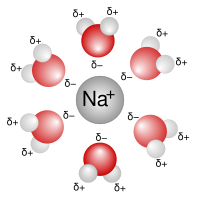
Photo from wikipedia
Hexachlorocyclohexane (HCH) and mainly the γ-HCH isomer, namely lindane, were extensively produced and used as pesticides. Huge amounts of wastes, solids and liquids, were disposed of in the surroundings of… Click to show full abstract
Hexachlorocyclohexane (HCH) and mainly the γ-HCH isomer, namely lindane, were extensively produced and used as pesticides. Huge amounts of wastes, solids and liquids, were disposed of in the surroundings of the production sites. The liquid residuum was a complex mixture of chlorinated organic compounds, COCs, from chlorobenzene to heptachlorocyclohexane. This Dense Non-Aqueous Phase Liquid, DNAPL, migrated by density through the subsurface to greater depths, being trapped or adsorbed into the soil in this movement posing a significant risk to the groundwater. Knowledge of the partitioning in water of COCs in DNAPL is a key issue to determine its fate in the environment. However, there are no data in literature for the partitioning and/or solubility of many of the COCs in this DNAPL, such as pentachlorocyclohexene, hexachlorocyclohexene and heptachlorocyclohexane despite them constitute about 13-30% of the mole fraction of the DNAPLs. In this work, the partitioning to water of COCs in free and those adsorbed onto soil has been studied. In addition, measured and predicted aqueous concentrations of each COC in the DNAPL mixture have been compared. To do this, the solubility of a compound that is a solid crystal when pure at P = 298 K and P = 1 atm has been evaluated considering the approach of sub-cooled liquid state of solid organochlorines. Samples were obtained at Sabiñanigo landfills and soils used had several grain sizes. Transformation in alkaline media of COCs had a positive environmental impact.
Journal Title: Chemosphere
Year Published: 2019
Link to full text (if available)
Share on Social Media: Sign Up to like & get
recommendations!